Bioremediation of Synthetic and Industrial Effluents by Aspergillus niger Isolated from Contaminated Soil Following a Sequential Strategy
Abstract
:1. Introduction
2. Results and Discussion
2.1. Fenton Treatment
2.2. Biological Treatment
2.2.1. Decolorization of Synthetic and Industrial Effluents by A. niger
2.3. Sequential Treatment
2.3.1. Fenton Treatment Followed by Biological Treatment
2.3.2. Biological Treatment Followed by Fenton Treatment
2.4. Mineralization Study
3. Materials and Methods
3.1. Chemicals
3.2. Preparation of Synthetic Effluent
3.3. Isolation of Microorganisms
3.4. Inoculum Preparation
3.5. Morphological Characterization of Isolated A. niger
3.6. Experimental Procedure for Fenton Treatment
3.7. Experimental Procedure for Biological Treatment
3.8. Decolorization Assay via UV-Vis Spectroscopy
3.9. Enzyme Studies
3.9.1. Lignin Peroxidase Assay
3.9.2. Manganese Peroxidase Assay
3.9.3. Laccase Assay
3.10. Mineralization Study
Acknowledgments
Author Contributions
Conflicts of Interest
References
- Pandey, A.; Singh, P.; Iyengar, L. Bacterial decolorization and degradation of azo dyes. Int. Biodeterior. Biodegrad. 2007, 59, 73–84. [Google Scholar] [CrossRef]
- Kiran, S.; Ali, S.; Asgher, M. Degradation and mineralization of azo dye reactive blue 222 by sequential photo-Fenton′s oxidation followed by aerobic biological treatment using white rot fungi. Bull. Environ. Contam. Toxicol. 2013, 90, 208–215. [Google Scholar] [CrossRef] [PubMed]
- Pinheiro, H.A. Physiological and Morphological Adaptations as Associated with Drought Tolerance in Robusta Coffee (Coffea canephora Pierre var. kouillou). Ph.D. Thesis, Federal University of Viçosa, Vicosa Minas Gerais, Brazil, February 2004. [Google Scholar]
- Gogate, P.R.; Pandit, A.B. A Review of Imperative Technologies for Wastewater Treatment I: Oxidation Technologies at Ambient Conditions. Adv. Environ. Res. 2004, 8, 501–551. [Google Scholar] [CrossRef]
- Hao, O.J.; Kim, H.; Chang, P.C. Decolorization of wastewater. Crit. Rev. Environ. Sci. Technol. 2000, 30, 449–505. [Google Scholar] [CrossRef]
- Gautam, M.; Azmi, W. Purification of extracellular collagenase from Pseudomonas sp. remarkable collagenolytic activity. Adv. Biotechnol. Microbiol. 2017, 4, 1–8. [Google Scholar]
- Guilard, C.; Disdier, J.; Monnet, C.; Dussaud, J.; Malato, S.; Aldonado, B.; Herrmann, J.M. Suspensions using artificial and solar light: Intermediates and degradation pathways. Appl. Catal. B. Environ. 2003, 46, 319–335. [Google Scholar]
- Ajao, A.T.; Adebayo, G.B.; Yakubu, S.E. Bioremediation of textile industrial effluent using mixed culture of Pseudomonas aeruginosa and Bacillus subtilis immobilized on agar agar in a bioreactor. J. Microbiol. Biotechnol. Res. 2017, 1, 50–56. [Google Scholar]
- Joshi, P.K.; Swarup, A.; Maheshwari, S.; Kumar, R.; Singh, N. Bioremediation of heavy metals in liquid media through fungi isolated from contaminated sources. Ind. J. Microbial. 2011, 51, 482–487. [Google Scholar] [CrossRef] [PubMed]
- Fu, Y.; Viraraghavan, T. Fungal decolorization of dye wastewaters. A review. Bioresour. Technol. 2001, 79, 251–262. [Google Scholar] [CrossRef]
- Guo, W.; Yang, Z.; Zhou, X.J.; Wu, Q. Degradation and mineralization of dyes with advanced oxidation processes (AOPs): A brief review. In Proceedings of the 2015 International Forum on Energy, Environment Science and Materials, Shenzhen, China, 25–26 September 2015; pp. 341–344. [Google Scholar]
- Sun, X.; Wang, C.; Li, Y.; Wang, W.; We, J. Treatment of phenolic wastewater by combined UF and NF/RO processes. Desalination 2015, 355, 68–74. [Google Scholar] [CrossRef]
- Chatha, S.A.S.; Kiran, S.; Gulzar, T.; Kamal, S.; Ghaffar, A.; Chatha, M.N. Comparative study on decolorisation and mineralisation of synthetic and real textile effluents using advanced oxidation processes. Oxid. Commun. 2016, 39, 1604–1614. [Google Scholar]
- Rashid, A.; Nosheen, S.; Kiran, S.; Bhatti, H.N.; Kamal, S.; Shamim, F.; Rafique, M.A. Combination of oxidation and coagulation processes for wastewater decontamination on batch scale. Oxid. Commun. 2016, 39, 1716–1726. [Google Scholar]
- Jain, B.; Singh, A.K.; Sharma, V.K. Degradation of naphthylazo anionic dye by Fenton and Fenton-like processes: a comparative study with Fast Sulphon Black-F. Desalin. Water Treat. 2017, 62, 252–256. [Google Scholar]
- Ali, N.F.; El-Mohamedy, R.S.R. Microbial decolourization of textile waste water. J. Saudi Chem. Soc. 2012, 16, 117–123. [Google Scholar] [CrossRef]
- Omar, S.A. Decolorization of Different Textile Dyes by Isolated Aspergillus niger. J. Environ. Sci. Technol. 2016, 9, 149–156. [Google Scholar] [CrossRef]
- Bergsten-Torralba, L.R.; Nishikawa, M.M.; Baptista, D.F.; Magalhaes, D.P.; Silva, M.D. Decolorization of different textile dyes by Penicillium simplicissimum and toxicity evaluation after fungal treatment. Braz. J. Microbiol. 2009, 40, 808–817. [Google Scholar] [CrossRef] [PubMed]
- Rana, R.S.; Singh, P.; Kandari, V.; Singh, R.; Dobhal, R.; Gupta, S. A review on characterization and bioremediation of pharmaceutical industries′ wastewater: An Indian perspective. Appl. Water Sci. 2017, 7, 1–12. [Google Scholar] [CrossRef]
- Punzi, M.; Anbalagan, A.; Börner, R.A.; Svensson, B.M.; Jonstrup, M.; Mattiasson, B. Degradation of a textile azo dye using biological treatment followed by photo-Fenton oxidation: Evaluation of toxicity and microbial community structure. Chem. Eng. J. 2015, 270, 290–299. [Google Scholar] [CrossRef]
- Ilyas, S.; Rehman, A. Decolorization and detoxification of Synozol red HF-6BN azo dye by Aspergillus niger and Nigrospora sp. J. Environ. Health Sci. Eng. 2013, 10, 12. [Google Scholar] [CrossRef] [PubMed]
- Taskin, M.; Serkan, E. Reactive dye bioaccumulation by fungus Aspergillus niger isolated from the effluent of sugar fabric-contaminated soil. Toxicol. Ind. Health 2010, 26, 239–247. [Google Scholar] [CrossRef] [PubMed]
- Bahmani, S.; Raj, B.; Boufounos, P.T. Greedy sparsity-constrained optimization. J. Mach. Learn. Res. 2013, 14, 807–841. [Google Scholar]
- Deepika, R.; Sathyabama, N.; Sankareswaran, M.; Anbalagan, S.; Vinayaga, M.D.; Kamalakkannan, V. Bioremediation of textile effluent with Aspergillus niger-based silver nanoparticles and its field trial. J. Environ. Sci. Comput. Sci. Eng. Technol. 2014, 3, 1156–1171. [Google Scholar]
- Rani, B.; Kumar, V.; Singh, J.; Bisht, S.; Teotia, P.; Sharma, S.; Kela, R. Bioremediation of dyes by fungi isolated from contaminated dye effluent sites for bio-usability. Braz. J. Microbiol. 2014, 45, 1055–1063. [Google Scholar] [CrossRef] [PubMed]
- Ali, H.; Ahmed, W.; Haq, T. Decolorization and degradation of malachite green by Aspergillus flavus and Alternaria solani. Afr. J. Biotechnol. 2009, 8, 1574–1576. [Google Scholar]
- Sharma, P.; Jha, A.B.; Dubey, R.S.; Pessarakli, M. Reactive oxygen species, oxidative damage, and antioxidative defense mechanism in plants under stressful conditions. J. Bot. 2012. [CrossRef]
- Kiran, S.; Ali, S.; Asgher, M.; Anwar, F. Comparative study on decolorization of Reactive Dye 222 by white rot fungi Pleurotus ostreatus IBL-02 and Phanerochaete chrysosporium IBL-03. Afr. J. Microbiol. Res. 2012, 6, 3639–3650. [Google Scholar]
- Waghmode, T.R.; Kurade, M.B.; Khandare, R.V.; Govindwar, S.P. A sequential aerobic/microaerophilic decolorization of sulfonated monoazo dye Golden Yellow HER by microbial consortium GG-BL. Int. Biodeterior. Biodegrad. 2011, 65, 1024–1034. [Google Scholar] [CrossRef]
- Waghmode, T.R.; Kurade, M.B.; Lade, H.S.; Govindwar, S.P. Decolorization and biodegradation of Rubine GFL by microbial consortium GG-BL in sequential aerobic/microaerophilic process. App. Biochem. Biotechnol. 2012, 167, 1578–1594. [Google Scholar] [CrossRef] [PubMed]
- Lade, H.; Kadam, A.; Paul, D.; Govindwar, S. Biodegradation and detoxification of textile azo dyes by bacterial consortium under sequential microaerophilic/aerobic processes. EXCLI J. 2015, 14, 158. [Google Scholar] [PubMed]
- Meerbergen, K.; Crauwels, S.; Willems, K.A.; Dewil, R.; Van-Impe, J.; Appels, L.; Lievens, B. Decolorization of reactive azo dyes using a sequential chemical and activated sludge treatment. J. Biosci. Bioengng. 2017, 124, 668–673. [Google Scholar] [CrossRef] [PubMed]
- Naimabadi, A.; Attar, H.M.; Shahsavani, A. Decolorization and biological degradation of azo dye Reactive Red 2 by anaerobic/aerobic sequential process. J. Environ. Health Sci. Eng. 2009, 6, 67–72. [Google Scholar]
- Bahmani, P.; Kalantary, R.R.; Esrafili, A.; Gholami, M.; Jafari, A.J. Evaluation of Fenton oxidation process coupled with biological treatment for the removal of Reactive Black 5 from aqueous solution. J. Environ. Health Sci. Eng. 2013, 11, 13. [Google Scholar] [CrossRef] [PubMed]
- Singh, S.; Pakshirajan, K. Enzyme activities and decolourization of single and mixed azo dyes by the white-rot fungus Phanerochaete chrysosporium. Int. Biodeterior. Biodegrad 2010, 64, 146–150. [Google Scholar] [CrossRef]
- Kiran, S.; Ali, S.; Asgher, M.; Shahid, S.A. Photo-fenton process: Optimization and decolourization and mineralization of Reactive Blue 222 dye. J. Environ. Sci. Water Resour. 2012, 1, 267–275. [Google Scholar]
- Naseer, A.; Nosheen, S.; Kiran, S.; Kamal, S.; Javaid, M.A.; Mustafa, M.; Tahir, A. Degradation and detoxification of Navy Blue CBF dye by native bacterial communities: an environmental bioremedial approach. Desalin. Water Treat. 2016, 57, 24070–24082. [Google Scholar] [CrossRef]
- Kiran, S.; Adeel, S.; Nosheen, S.; Hassan, A.; Usman, M.; Rafique, M.A. Recent trends in textile effluent treatments: A review. Adv. Mater. Wastewater Treat. 2017, 29–49. [Google Scholar] [CrossRef]
- Larone, DH. Medically Important Fungi: A Guide to Identification, 4th ed.; American Society for Microbiology Press: Washington, DC, USA, 2002. [Google Scholar]
- Qin, X.; Sun, X.; Huang, H.; Bai, Y.; Wang, Y.; Luo, H.; Su, X. Oxidation of a non-phenolic lignin model compound by two Irpex lacteus manganese peroxidases: Evidence for implication of carboxylate and radicals. Biotechnol. Biofuels 2017, 10, 103. [Google Scholar] [CrossRef] [PubMed]
- Mishra, B.; Kumbhare, L.B.; Jain, V.K.; Priyadarsini, K.I. Pulse radiolysis studies on reactions of hydroxyl radicals with selenocystine derivatives. J. Phys. Chem. B 2008, 112, 4441–4446. [Google Scholar] [CrossRef] [PubMed]
- Datta, R.; Kelkar, A.; Baraniya, D.; Molaei, A.; Moulick, A.; Meena, R.S.; Formanek, P. Enzymatic degradation of lignin in soil: A review. Sustainability 2017, 9, 1163. [Google Scholar] [CrossRef]
- Greenberg, A.E.; Trussel, R.L.; Clesceri, L.S. Standard Methods for the Examination of Water and Wastewater, 20th ed.; American Public Health Association: St. Louis, MO, USA, 1985. [Google Scholar]
Sample Availability: Samples of the compounds are not available from the authors. |

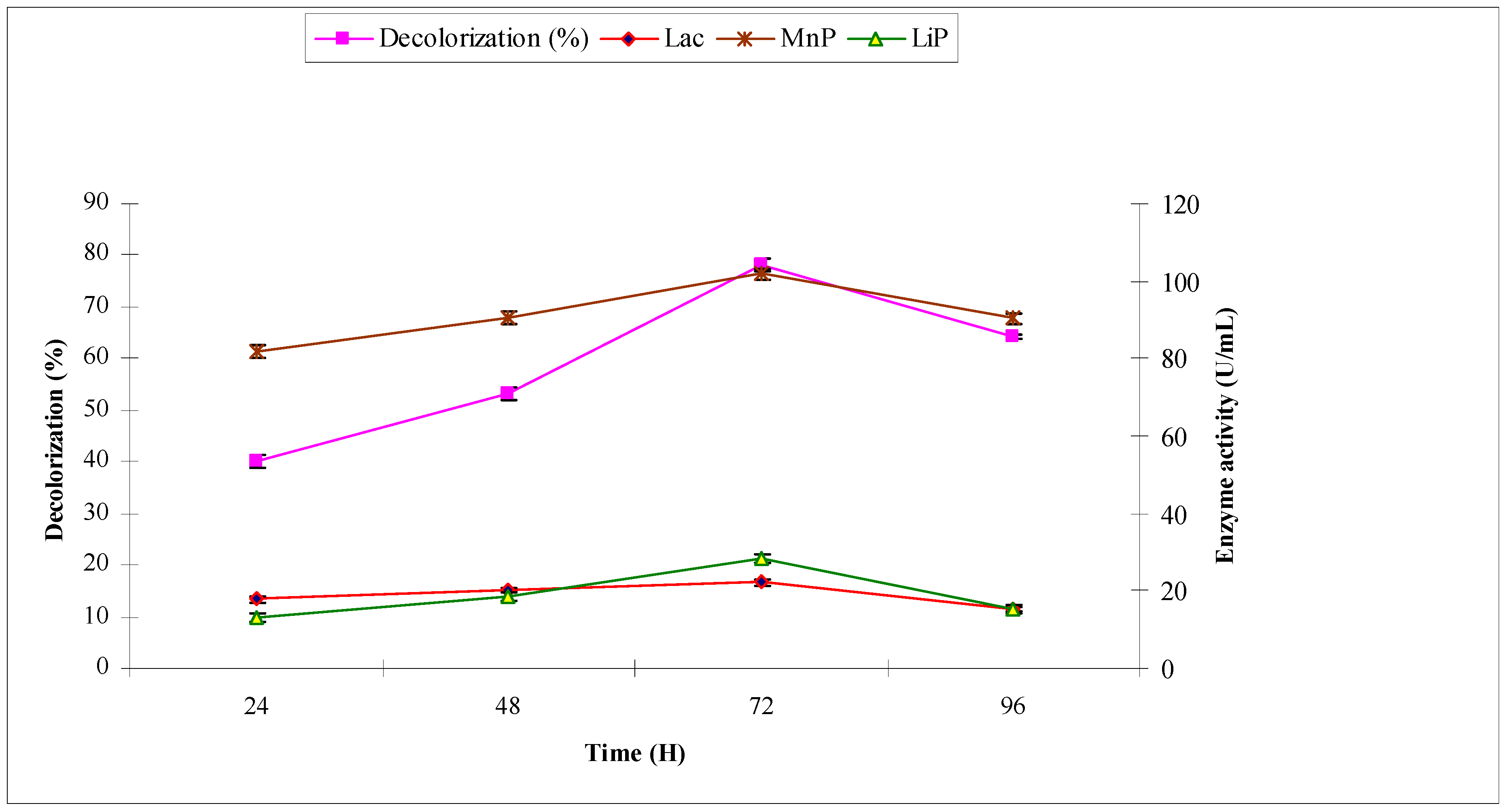

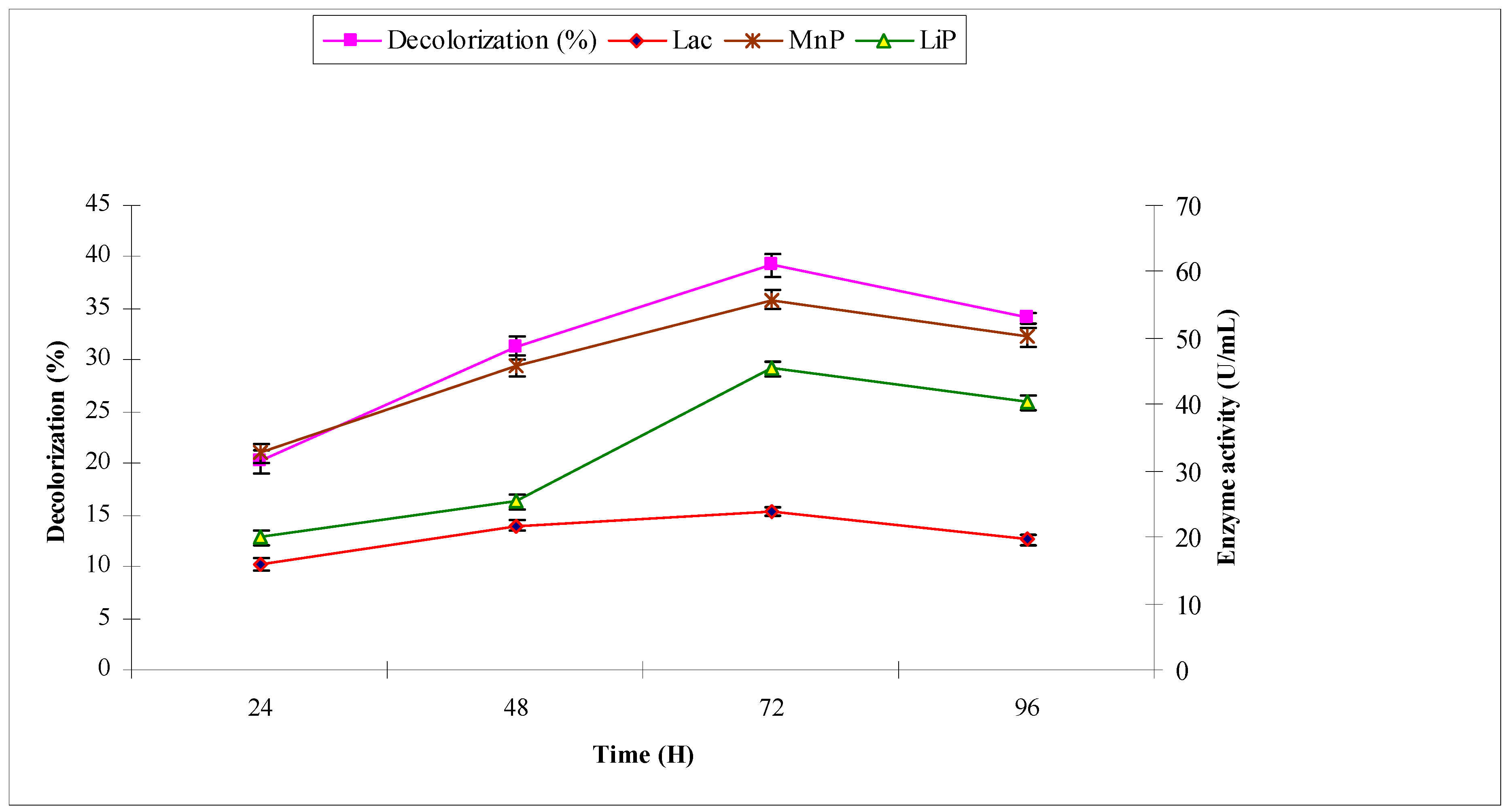
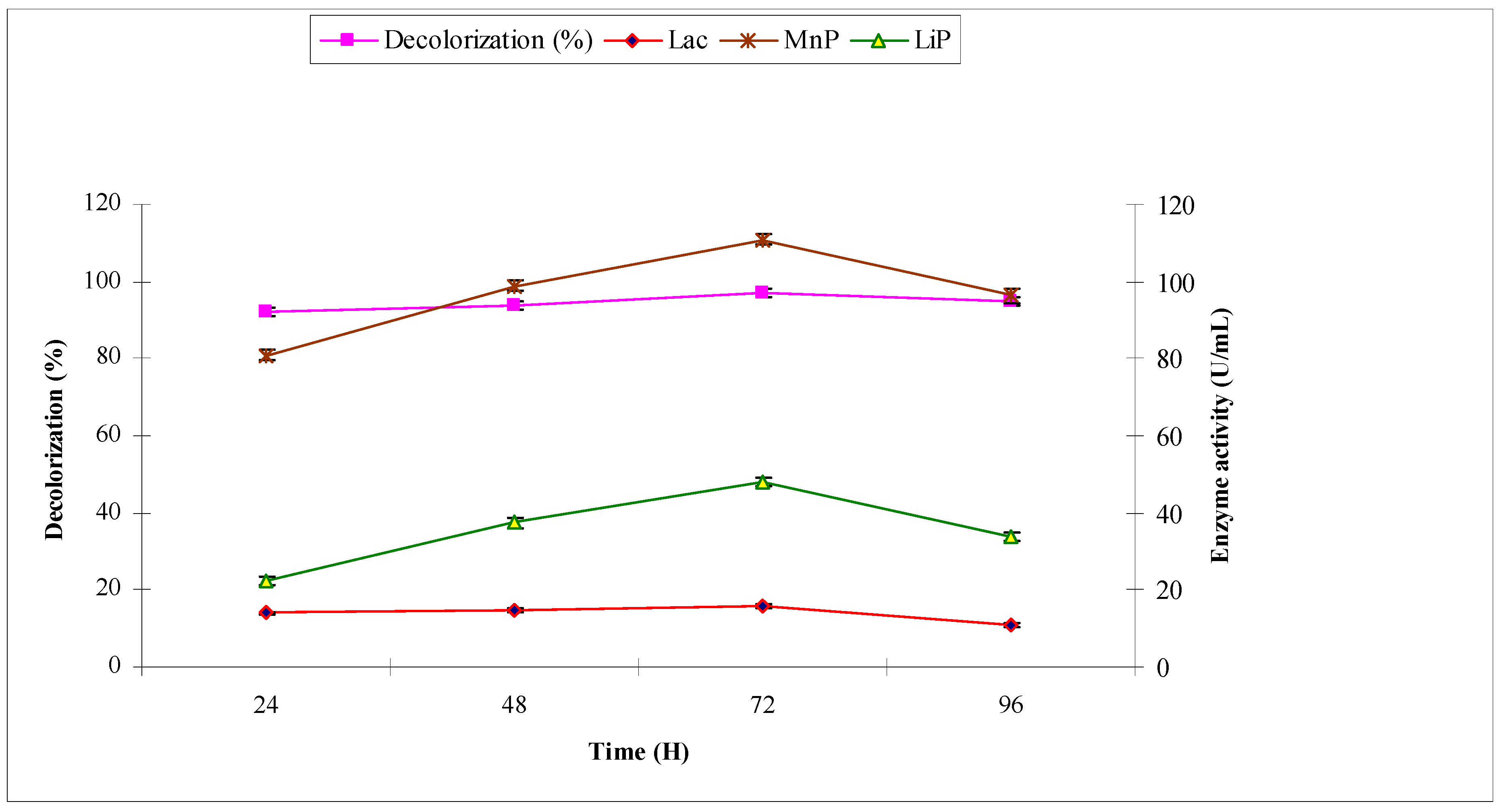
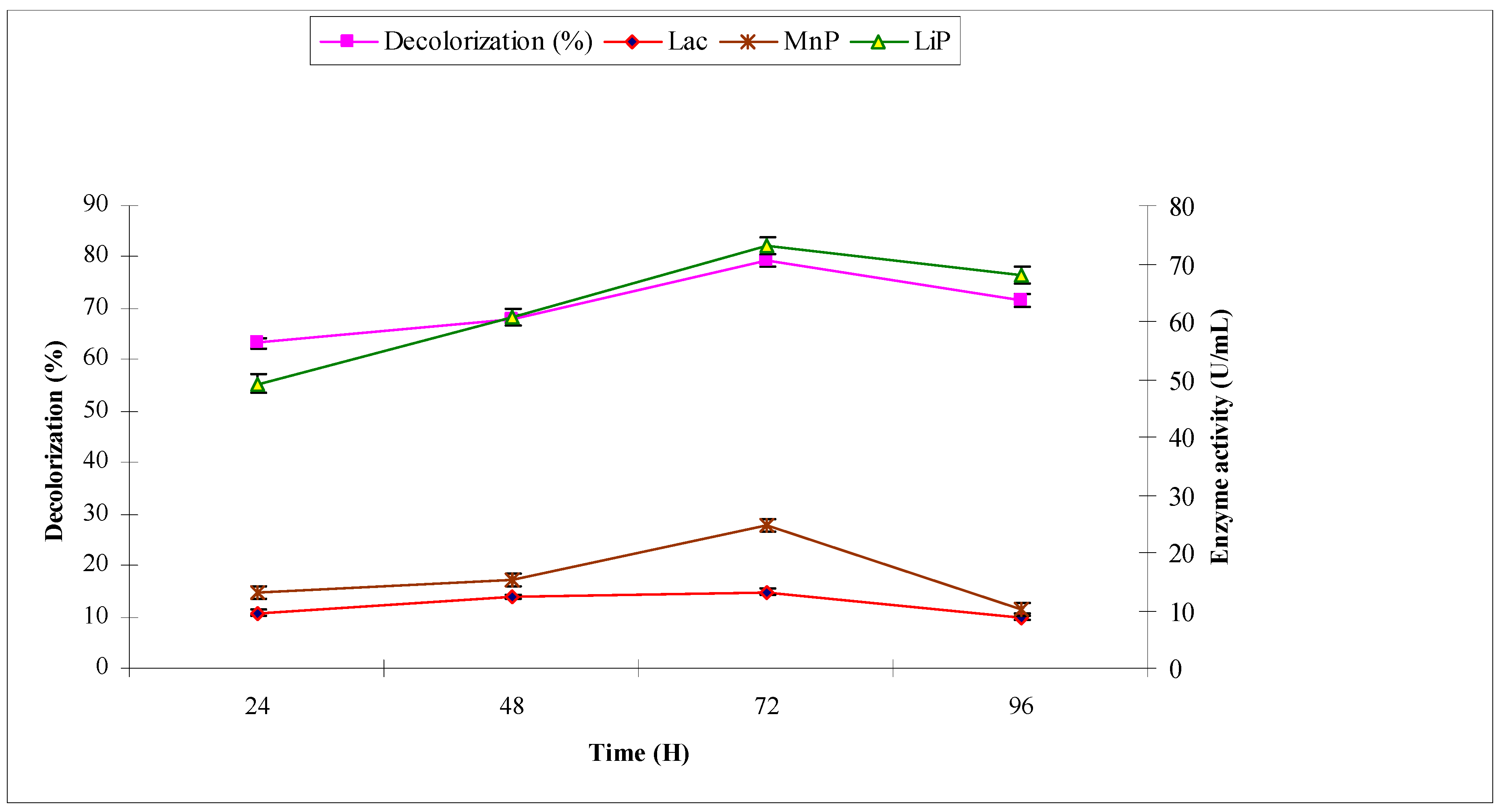


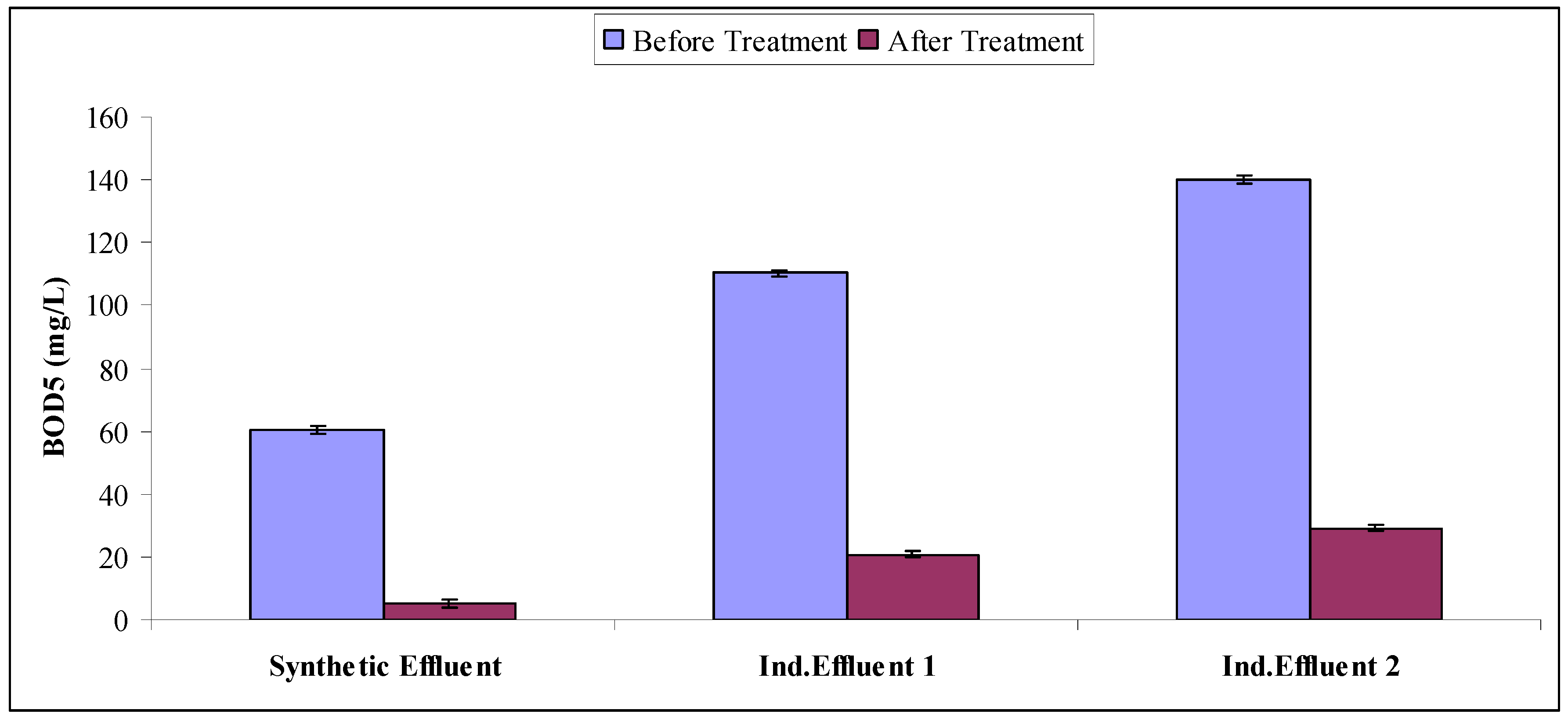
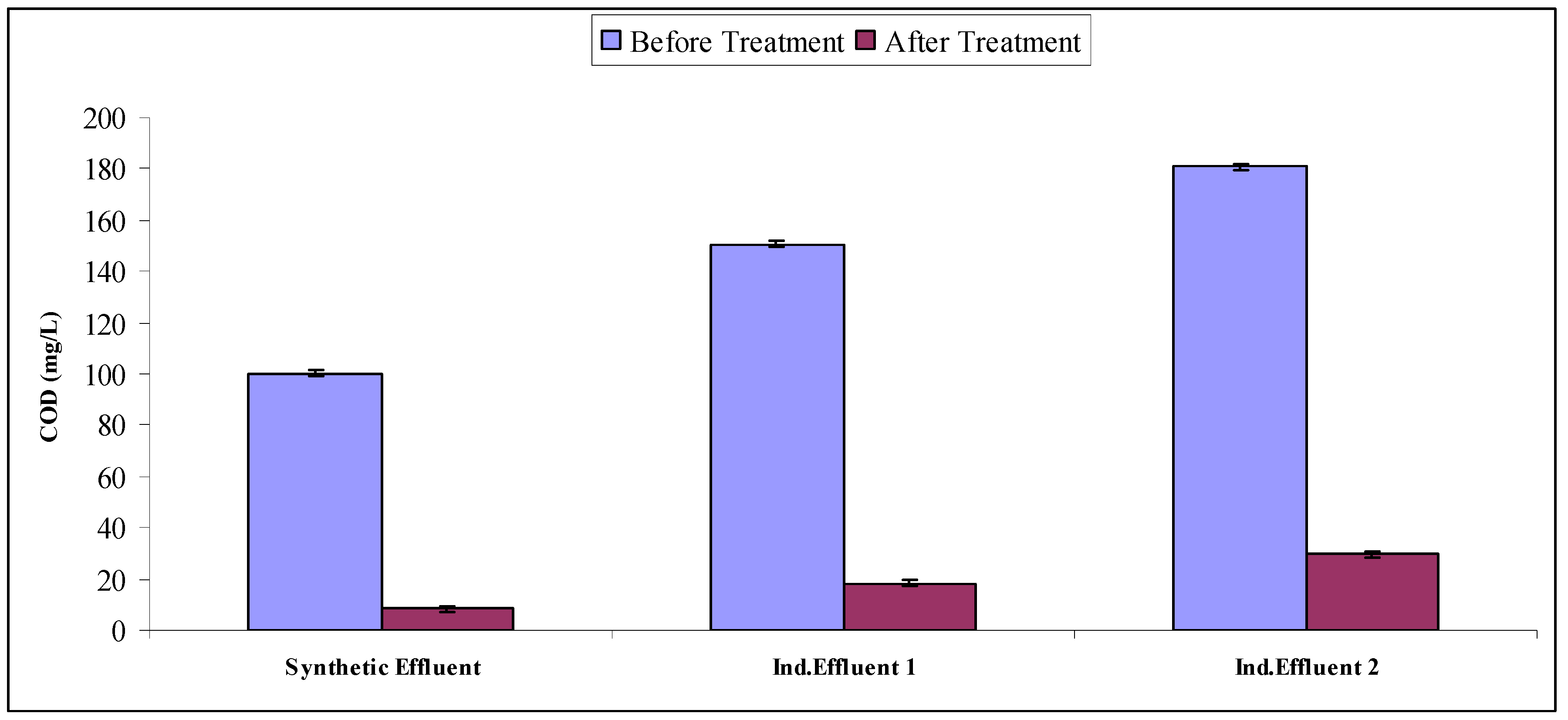
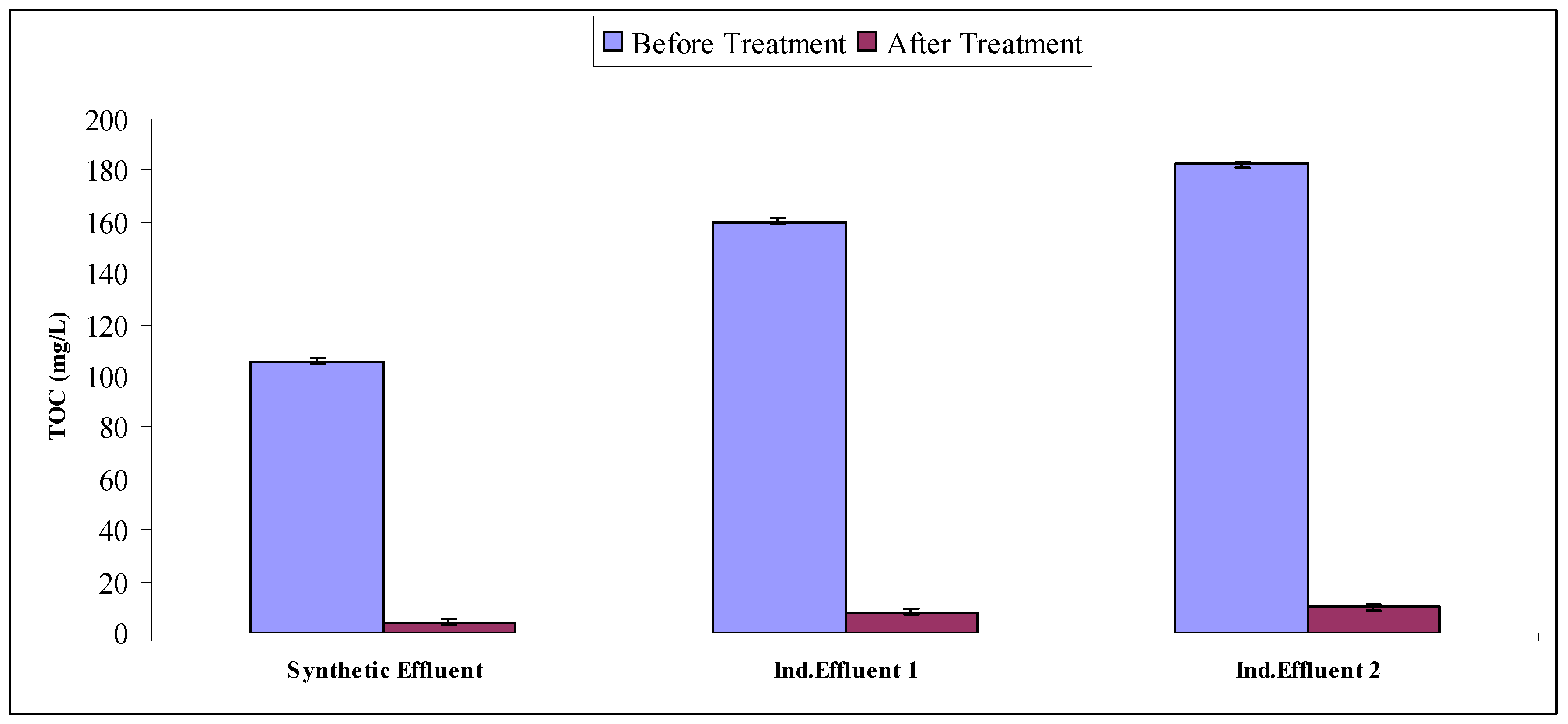
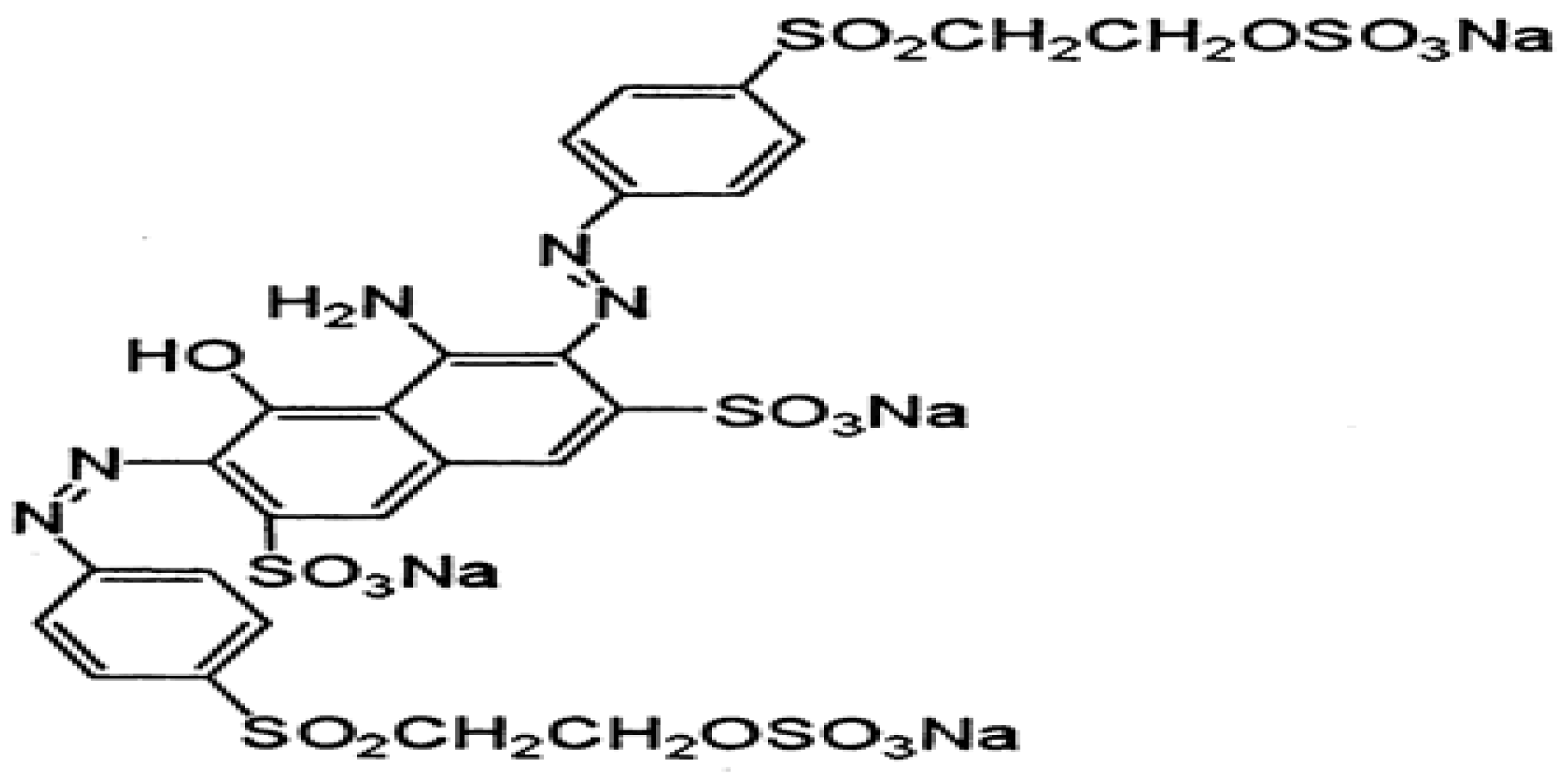
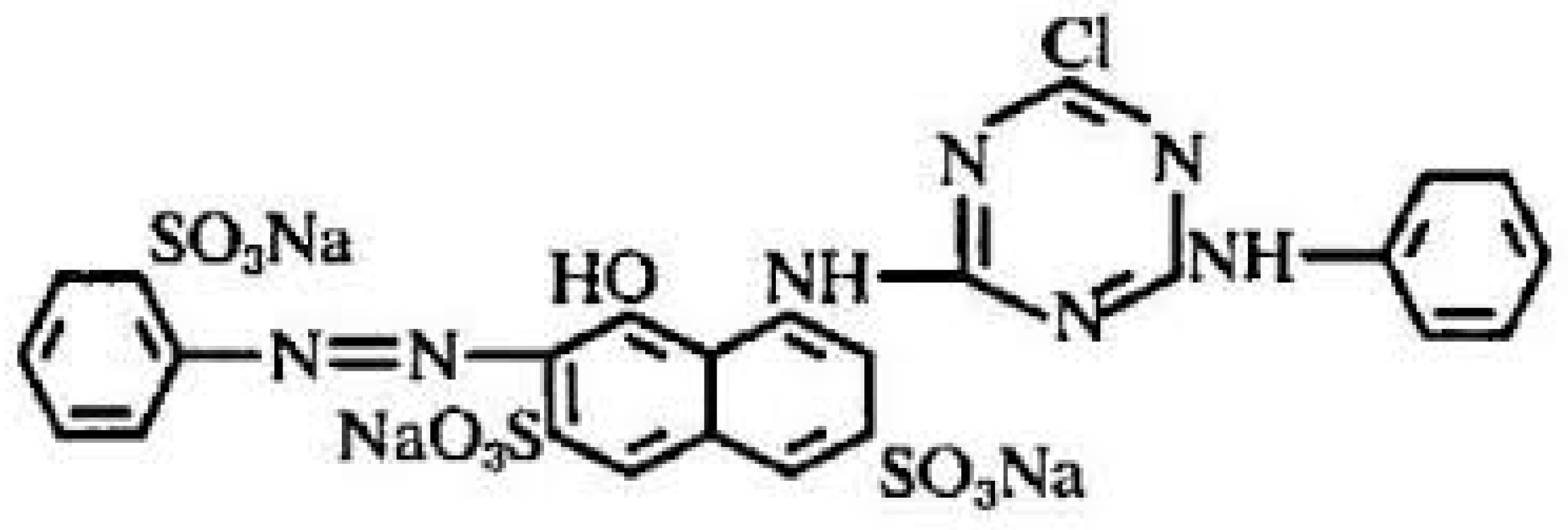

© 2017 by the authors. Licensee MDPI, Basel, Switzerland. This article is an open access article distributed under the terms and conditions of the Creative Commons Attribution (CC BY) license (http://creativecommons.org/licenses/by/4.0/).
Share and Cite
Gulzar, T.; Huma, T.; Jalal, F.; Iqbal, S.; Abrar, S.; Kiran, S.; Nosheen, S.; Hussain, W.; Rafique, M.A. Bioremediation of Synthetic and Industrial Effluents by Aspergillus niger Isolated from Contaminated Soil Following a Sequential Strategy. Molecules 2017, 22, 2244. https://doi.org/10.3390/molecules22122244
Gulzar T, Huma T, Jalal F, Iqbal S, Abrar S, Kiran S, Nosheen S, Hussain W, Rafique MA. Bioremediation of Synthetic and Industrial Effluents by Aspergillus niger Isolated from Contaminated Soil Following a Sequential Strategy. Molecules. 2017; 22(12):2244. https://doi.org/10.3390/molecules22122244
Chicago/Turabian StyleGulzar, Tahsin, Tayyaba Huma, Fatima Jalal, Sarosh Iqbal, Shazia Abrar, Shumaila Kiran, Sofia Nosheen, Waqar Hussain, and Muhammad Asim Rafique. 2017. "Bioremediation of Synthetic and Industrial Effluents by Aspergillus niger Isolated from Contaminated Soil Following a Sequential Strategy" Molecules 22, no. 12: 2244. https://doi.org/10.3390/molecules22122244



